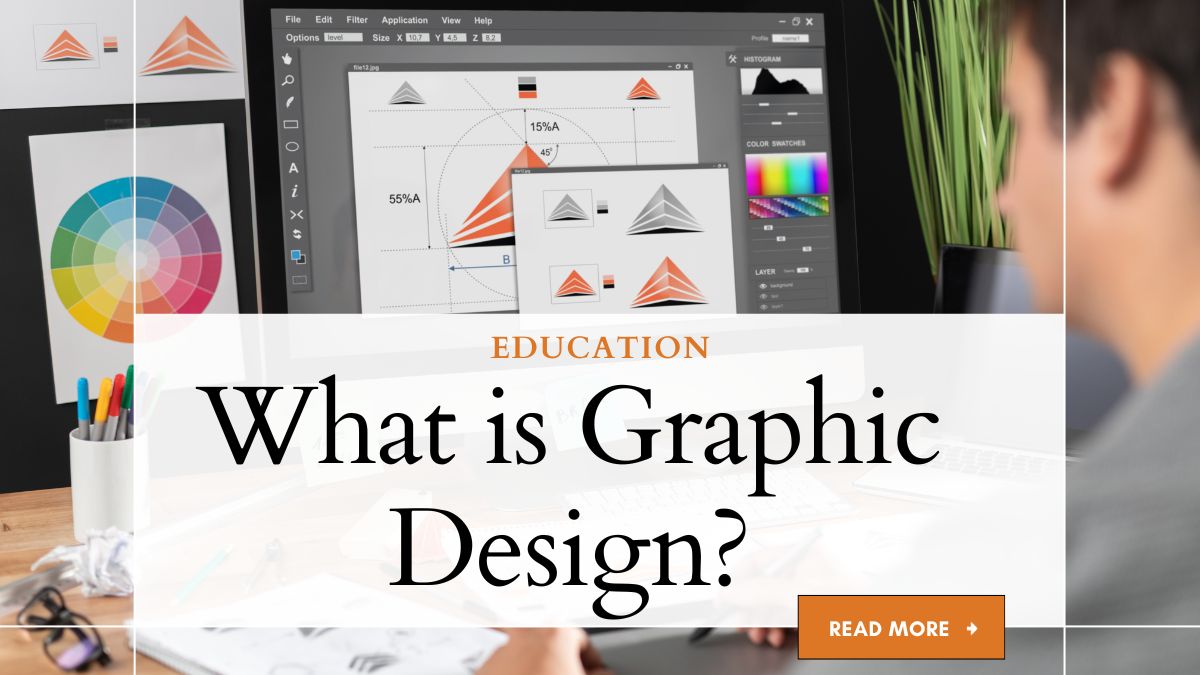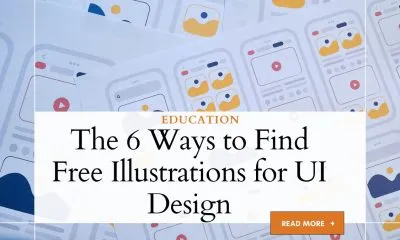
Embarking on a journey through the vibrant and ever-evolving landscape of graphic design, we uncover a world where creativity and functionality intertwine.
Graphic design, often misconstrued as mere decoration, is in fact a potent tool for communication and expression.
Its applications span from the pages of ancient manuscripts to the dynamic interfaces of modern web applications, demonstrating its pervasive influence on our daily lives.
This exploration aims not just to define graphic design but to delve into its profound impact on how we interact with the world around us.
Also, you can able to know,
The Essence of Graphic Design
Graphic design is an artistic and professional discipline that marries creativity with functionality.
In this section, we delve into what graphic design truly entails, exploring its fundamental concepts and the role it plays beyond just visual aesthetics.
This exploration will help us understand how graphic design not only beautifies but also facilitates effective communication and problem-solving through its various forms.
Defining the Indefinable: Core Concepts of Graphic Design
At its heart, graphic design is an art form that focuses on visual communication and problem-solving through the use of typography, photography, iconography, and illustration.
The discipline involves a strategic blend of aesthetics and functionality to convey specific messages to targeted audiences.
It’s an amalgamation of art and technology, where designers harness their creativity to produce compelling visuals that effectively convey ideas and engage audiences.
Beyond Aesthetics: The Functionality of Design
Graphic design transcends mere visual stimulation; it is a key player in the realm of functional art.
Its influence extends into various aspects of our lives, shaping the way we perceive and interact with the world.
From the user interface of a mobile app to the layout of a website, from branding materials to product packaging, graphic design enhances usability, guides behavior, and plays a crucial role in decision-making processes.
Elements and Principles: The Building Blocks
Every masterpiece in graphic design starts with basic elements and principles.
Here, we dissect the core components such as color, line, shape, and texture, and principles like balance, hierarchy, and contrast.
Understanding these building blocks is crucial for anyone looking to grasp the subtleties of what makes a design not just visually appealing, but also functionally effective and engaging.
The Visual Elements: Color, Line, Shape, and Texture
The visual elements of graphic design – color, line, shape, and texture – are the fundamental components that make up a design.
Color dictates mood and creates atmosphere, lines direct focus and define boundaries, shapes form the foundation of layouts and graphics, while texture adds depth and sensory perception to the visual experience.
The masterful manipulation of these elements is what transforms a simple design into a captivating piece of art.
Principles in Action: Balance, Hierarchy, and Contrast
The principles of balance, hierarchy, and contrast act as the guiding forces behind effective graphic design.
Balance ensures stability and structure in a composition, hierarchy directs the viewer’s attention to key elements, and contrast highlights the differences, creating focal points and interest.
These principles are not mere rules but tools that, when skillfully applied, can significantly enhance the communicative power of a design.
Types and Applications: The Many Faces of Graphic Design
Graphic design manifests in a myriad of forms and serves a multitude of purposes.
In this section, we explore the diverse types of graphic design, from traditional print to modern digital formats, and examine the various real-world applications.
This comprehensive overview illustrates the pervasive nature of graphic design in everyday life and its power to influence and inform.
From Print to Digital: Understanding Various Formats
Graphic design’s versatility is evident in its wide range of types and applications.
From traditional print media like magazines, newspapers, and flyers, to modern digital formats including websites, online ads, and social media graphics, the scope of graphic design is vast and varied.
Each format presents its unique challenges and opportunities, requiring designers to constantly adapt and innovate.
Real-World Examples: Where Design Meets Life
The real-world impact of graphic design is undeniable. It shapes our interactions with everyday products and services, from the elegance of a well-designed book cover to the user-friendliness of a mobile app.
In the corporate sphere, it plays a crucial role in branding and identity, helping businesses establish a visual presence and connect with their audience.
In public spaces, effective graphic design facilitates navigation, instruction, and information dissemination.
Tools of the Trade: The Designer’s Toolkit
The tools of the trade in graphic design have evolved significantly, from traditional implements to advanced digital software.
This section is dedicated to understanding these tools, both old and new, and their roles in the creative process.
We explore how these tools shape the work of designers and the creative possibilities they unlock.
Traditional Tools: A Nod to the Past
Traditional tools in graphic design, such as pencils, pens, markers, and paper, have been the foundation of the design process for decades.
These tools offer a tactile and direct approach to creativity, often serving as the starting point for brainstorming and initial concept development.
Even in an increasingly digital world, these traditional methods hold significant value for their simplicity and directness.
Digital Domination: Software That Shapes the Industry
In the contemporary world of design, digital tools and software have become indispensable.
Programs like Adobe Photoshop, Illustrator, and InDesign are mainstays in a graphic designer’s arsenal, offering unparalleled capabilities in image editing, vector graphics, and layout design.
The evolution of these tools has expanded the boundaries of what can be achieved in graphic design, enabling more complex, intricate, and refined works.
The Creative Process: From Conception to Completion
The journey of creating a design is intricate and multifaceted. This part of the article delves into the creative process of graphic design, from the initial spark of an idea through to the development and final execution.
We explore various techniques and stages that designers go through to bring their visions to life, highlighting the blend of creativity and technicality involved.
The Birth of an Idea: Conceptualization Techniques
The creative process in graphic design begins with the conceptualization phase, where ideas are born and visions start to take shape.
This stage involves a blend of research, brainstorming, and sketching, as designers seek inspiration and explore different concepts.
Techniques such as mind mapping, mood boards, and thumbnail sketches are commonly employed to stimulate creativity and refine ideas.
Bringing Ideas to Life: Design Development and Execution
Following conceptualization, the design development phase involves translating ideas into tangible designs.
This stage requires a meticulous balance of creativity and technical skill, as designers experiment with layouts, typography, color schemes, and imagery.
The execution phase sees the final design come to life, where attention to detail, precision, and a keen eye for aesthetics are crucial to achieving a successful outcome.
Graphic Design in the Digital Era
The digital era has transformed the landscape of graphic design. In this section, we examine how technological advancements have revolutionized the field, leading to new genres and techniques.
We also look at the rise of web and UX/UI design, underscoring the importance of digital platforms in the modern world of design.
Embracing Technology: The Digital Transformation
The digital era has brought about transformative changes in graphic design.
The advent of advanced software and technology has not only streamlined the design process but also expanded the possibilities for creativity and innovation.
This technological revolution has led to the emergence of new genres and techniques in design, such as 3D modeling, digital illustration, and interactive multimedia.
The Rise of Web and UX/UI Design
With the proliferation of digital platforms, web and UX/UI design have become integral components of graphic design.
These fields focus on enhancing the user’s experience and interaction with digital products and services.
Web design combines aesthetic appeal with functionality, ensuring websites are visually engaging and easy to navigate.
UX/UI design delves into the usability of digital interfaces, prioritizing user-centric approaches to create intuitive and user-friendly experiences.
Educational Pathways to Becoming a Graphic Designer
Becoming a graphic designer can be achieved through various educational routes.
This part of the article compares formal education with self-taught approaches and discusses the essential skills required in the industry today.
We aim to provide insights for aspiring designers on how to navigate their educational and skill-building journey in this dynamic field.
Formal Education vs. Self-Taught Skills
The journey to becoming a graphic designer can follow various educational pathways.
Formal education in the form of degrees or diplomas from design schools provides a structured learning environment, offering comprehensive training and exposure to different aspects of design.
On the other hand, the self-taught route allows for flexibility and personalized learning, with resources like online courses, tutorials, and workshops available for aspiring designers to hone their skills.
Essential Skills for Today’s Graphic Designer
Beyond artistic talent, contemporary graphic designers need a diverse set of skills to thrive in the industry.
These include proficiency in design software, understanding of design theory and principles, strong communication abilities, and problem-solving skills.
Additionally, staying abreast of current trends, technological advancements, and emerging tools is crucial for designers to remain relevant and competitive in the field.
The Business of Graphic Design
Graphic design is not just a creative endeavor but also a profession with diverse career paths.
This section explores the business side of graphic design, including the differences between freelancing and working in an agency, and the importance of crafting a compelling portfolio.
It provides a glimpse into the professional world of graphic design and what it takes to succeed.
Freelancing or Agency: Career Paths Explored
Graphic designers have the flexibility to choose between various career paths. Freelancing offers autonomy and the freedom to choose projects, while working in an agency or as part of an in-house team provides collaborative opportunities and a steady workflow.
Each path has its own set of challenges and rewards, and the choice often depends on the individual’s work style, preferences, and career goals.
Crafting a Compelling Portfolio
A strong portfolio is the cornerstone of a graphic designer’s career. It is a curated collection of their best work, showcasing their skills, style, and versatility.
A compelling portfolio not only demonstrates a designer’s technical abilities but also their creative thought process and problem-solving prowess.
It is a dynamic tool that evolves with the designer’s career, playing a crucial role in securing clients and job opportunities.
Graphic Design and Society
Graphic design plays a significant role in society, reflecting cultural trends and influencing social change.
Here, we explore how cultural influences shape design and the impact of graphic design in various social contexts.
This section highlights the power of design as a tool for communication and advocacy in societal issues.
Cultural Influences in Design
Graphic design is deeply intertwined with culture, reflecting societal values, trends, and historical contexts.
It acts as a visual language that can transcend linguistic barriers, conveying messages that resonate with diverse audiences.
Designers often draw inspiration from cultural motifs, symbols, and narratives, infusing their work with a richness that enhances its relevance and appeal.
The Role of Design in Social Change
Beyond commercial applications, graphic design has a profound role in driving social change.
It is a powerful tool for advocacy and awareness, capable of conveying complex messages in an accessible and impactful manner.
From public awareness campaigns to social movements, graphic design amplifies voices, fosters dialogue, and encourages action, highlighting its significance as a force for societal transformation.
Staying Ahead: Trends and Future of Graphic Design
In a field as dynamic as graphic design, staying abreast of trends and future predictions is crucial.
This final section looks at emerging trends, potential future developments, and how designers can adapt to these changes.
We discuss the evolving role of the graphic designer in a world where technology and societal needs are constantly shifting.
What’s Next: Predictions and Emerging Trends
The landscape of graphic design is continuously evolving, shaped by changing technologies, cultural shifts, and consumer behaviors.
Predictions for the future of design include increased integration of virtual and augmented reality, a stronger emphasis on sustainability and ethical design, and the continued rise of personalized, user-centric experiences.
Adapting to Change: The Evolving Role of the Graphic Designer
As the field evolves, so does the role of the graphic designer. Staying ahead in the industry requires adaptability, a willingness to learn new skills, and a proactive approach to embracing change.
Designers must continually refine their craft, explore new technologies, and remain sensitive to the shifting needs and preferences of audiences, ensuring their work remains relevant and impactful.
Don’t miss: How to Become a Graphic Designer Without a Degree
The bottom line
Graphic design is a dynamic and influential field that shapes our visual landscape and influences our perceptions and interactions.
From functional applications to artistic expressions, it plays a vital role in a myriad of contexts, impacting businesses, societies, and individuals alike.
As we look to the future, the importance of graphic design is set to grow, adapting to new challenges and opportunities presented by an increasingly digital world.
Designers, equipped with their creative prowess and technical skills, stand at the forefront of this evolution, crafting visual experiences that not only please the eye but also engage the mind and heart.
As we navigate through this ever-changing domain, one thing remains clear: graphic design is not just about creating something that looks good; it’s about creating something that resonates, communicates, and endures.
Whether it’s through a striking logo, a user-friendly website, or a powerful social campaign, graphic design continues to be an essential tool in shaping our world and our experiences within it.












